technical data SKODA ROOMSTER 2008 1.G Repair Manual
[x] Cancel search | Manufacturer: SKODA, Model Year: 2008, Model line: ROOMSTER, Model: SKODA ROOMSTER 2008 1.GPages: 248, PDF Size: 46.44 MB
Page 126 of 248
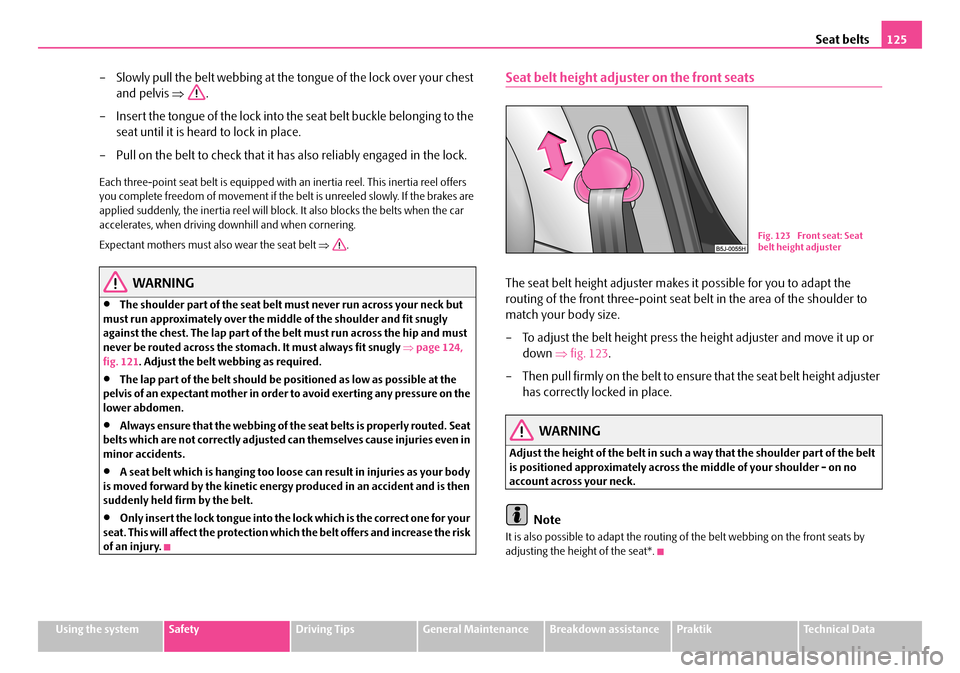
Seat belts125
Using the systemSafetyDriving TipsGeneral MaintenanceBreakdown assistancePraktikTechnical Data
– Slowly pull the belt webbing at the tongue of the lock over your chest
and pelvis ⇒.
– Insert the tongue of the lock into th e seat belt buckle belonging to the
seat until it is heard to lock in place.
– Pull on the belt to check that it has also reliably engaged in the lock.
Each three-point seat belt is equipped with an inertia reel. This inertia reel offers you complete freedom of movement if the belt is unreeled slowly. If the brakes are applied suddenly, the inertia reel will block. It also blocks the belts when the car accelerates, when driving downhill and when cornering.
Expectant mothers must also wear the seat belt ⇒.
WARNING
•The shoulder part of the seat belt must never run across your neck but must run approximately over the middl e of the shoulder and fit snugly against the chest. The lap part of the belt must run across the hip and must never be routed across the stomach. It must always fit snugly ⇒page 124, fig. 121 . Adjust the belt webbing as required.
•The lap part of the belt should be positioned as low as possible at the pelvis of an expectant mother in order to avoid exerting any pressure on the lower abdomen.
•Always ensure that the webbing of the seat belts is properly routed. Seat belts which are not correctly adjusted ca n themselves cause injuries even in minor accidents.
•A seat belt which is hanging too loose can result in injuries as your body is moved forward by the kinetic energy produced in an accident and is then suddenly held firm by the belt.
•Only insert the lock tongue into the lo ck which is the correct one for your seat. This will affect the protection whic h the belt offers and increase the risk of an injury.
Seat belt height adjuster on the front seats
The seat belt height adjuster makes it possible for you to adapt the
routing of the front three-point seat belt in the area of the shoulder to
match your body size.
– To adjust the belt height press the height adjuster and move it up or
down ⇒fig. 123.
– Then pull firmly on the belt to ensure that the seat belt height adjuster
has correctly locked in place.
WARNING
Adjust the height of the belt in such a way that the shoulder part of the belt is positioned approximately across the middle of your shoulder - on no account across your neck.
Note
It is also possible to adapt the routing of the belt webbing on the front seats by adjusting the height of the seat*.
Fig. 123 Front seat: Seat belt height adjuster
NKO A05R 20 MR08.book Page 125 Wednesday, March 28, 2007 9:42 AM
Page 128 of 248
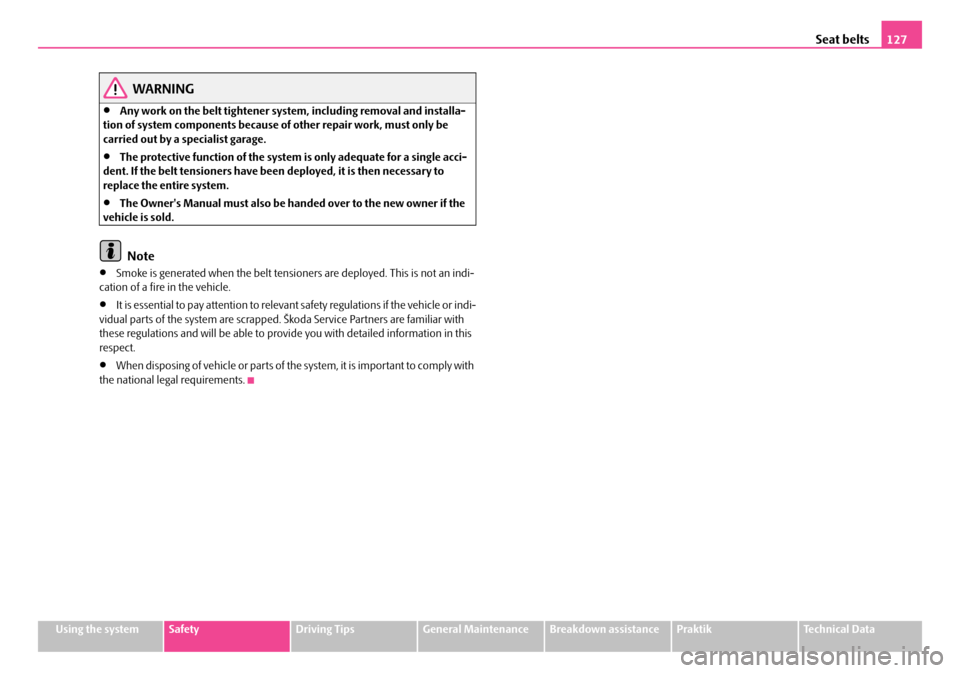
Seat belts127
Using the systemSafetyDriving TipsGeneral MaintenanceBreakdown assistancePraktikTechnical Data
WARNING
•Any work on the belt tightener system, including removal and installa- tion of system components because of other repair work, must only be carried out by a specialist garage.
•The protective function of the system is only adequate for a single acci- dent. If the belt tensioners have been deployed, it is then necessary to replace the entire system.
•The Owner's Manual must also be ha nded over to the new owner if the vehicle is sold.
Note
•Smoke is generated when the belt tensione rs are deployed. This is not an indi- cation of a fire in the vehicle.
•It is essential to pay attention to relevant safety regulations if the vehicle or indi- vidual parts of the system are scrapped. Škoda Service Partners are familiar with these regulations and will be able to provide you with detailed information in this respect.
•When disposing of vehicle or parts of the system, it is important to comply with the national legal requirements.
NKO A05R 20 MR08.book Page 127 Wednesday, March 28, 2007 9:42 AM
Page 130 of 248
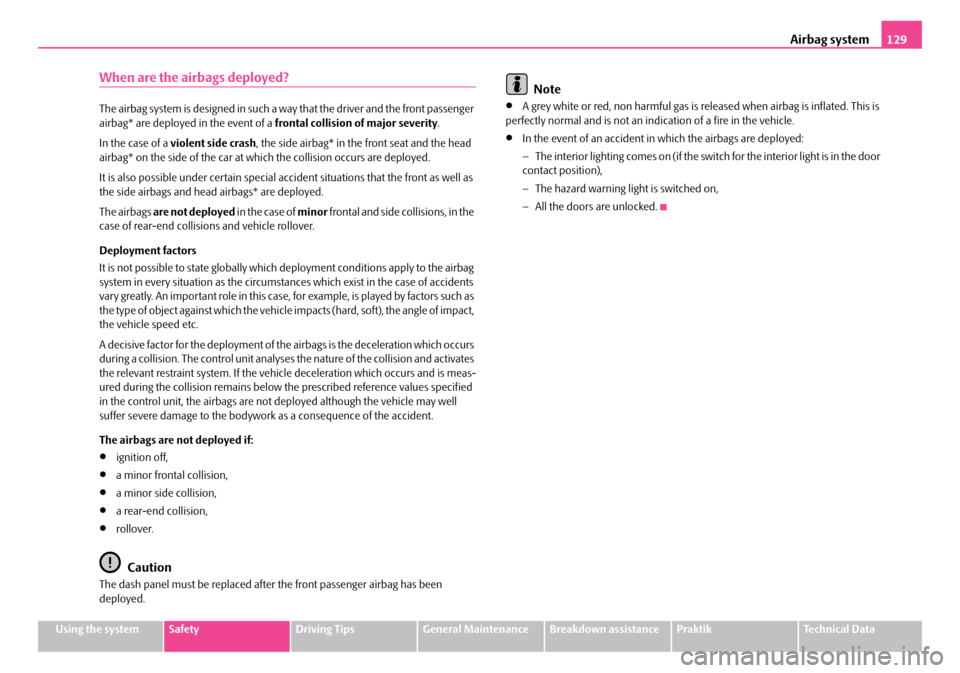
Airbag system129
Using the systemSafetyDriving TipsGeneral MaintenanceBreakdown assistancePraktikTechnical Data
When are the airbags deployed?
The airbag system is designed in such a way that the driver and the front passenger airbag* are deployed in the event of a frontal collision of major severity.
In the case of a violent side crash, the side airbag* in the front seat and the head airbag* on the side of the car at which the collision occurs are deployed.
It is also possible under cert ain special accident situations that the front as well as the side airbags and head airbags* are deployed.
The airbags are not deployed in the case of minor frontal and side collisions, in the case of rear-end collisi ons and vehicle rollover.
Deployment factors
It is not possible to state globally which deployment conditions apply to the airbag system in every situation as the circumstances which exist in the case of accidents vary greatly. An important role in this case , for example, is played by factors such as the type of object against which the vehicle impacts (hard, soft), the angle of impact, the vehicle speed etc.
A decisive factor for the deployment of the airbags is the deceleration which occurs during a collision. The control unit analyses the nature of the collision and activates the relevant restraint system. If the vehi cle deceleration which occurs and is meas- ured during the collision remains below the prescribed reference values specified in the control unit, the airbags are not deployed although the vehicle may well suffer severe damage to the bodywork as a consequence of the accident.
The airbags are not deployed if:
•ignition off,
•a minor frontal collision,
•a minor side collision,
•a rear-end collision,
•rollover.
Caution
The dash panel must be replaced afte r the front passenger airbag has been deployed.
Note
•A grey white or red, non harmful gas is released when airbag is inflated. This is perfectly normal and is not an indi cation of a fire in the vehicle.
•In the event of an accident in which the airbags are deployed:
− The interior lighting comes on (if the switch for the interior light is in the door contact position),
− The hazard warning light is switched on,
− All the doors are unlocked.
NKO A05R 20 MR08.book Page 129 Wednesday, March 28, 2007 9:42 AM
Page 132 of 248
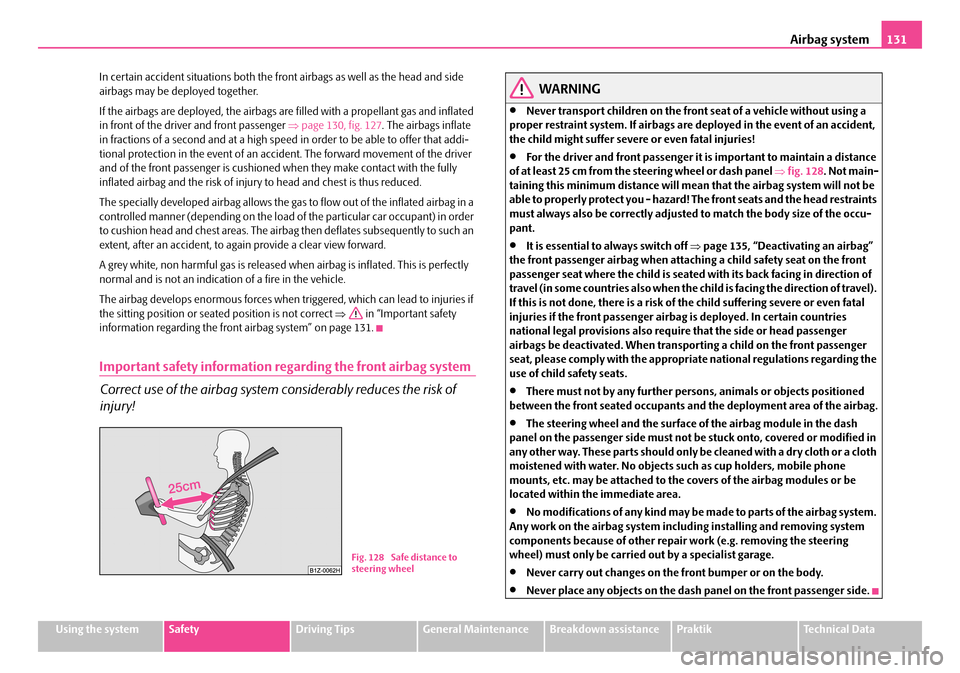
Airbag system131
Using the systemSafetyDriving TipsGeneral MaintenanceBreakdown assistancePraktikTechnical Data
In certain accident situations both the front airbags as well as the head and side airbags may be deployed together.
If the airbags are deployed, the airbags are filled with a propellant gas and inflated in front of the driver and front passenger ⇒page 130, fig. 127. The airbags inflate in fractions of a second and at a high speed in order to be able to offer that addi- tional protection in the event of an acci dent. The forward movement of the driver and of the front passenger is cushioned when they make contact with the fully inflated airbag and the risk of injury to head and chest is thus reduced.
The specially developed airbag allows the gas to flow out of the inflated airbag in a controlled manner (depending on the load of the particular car occupant) in order to cushion head and chest areas. The airbag then deflates subsequently to such an extent, after an accident, to again provide a clear view forward.
A grey white, non harmful gas is released when airbag is inflated. This is perfectly normal and is not an indication of a fire in the vehicle.
The airbag develops enormous forces when triggered, which can lead to injuries if the sitting position or seated position is not correct ⇒ in “Important safety information regarding the front airbag system” on page 131.
Important safety information regarding the front airbag system
Correct use of the airbag system considerably reduces the risk of
injury!
WARNING
•Never transport children on the front seat of a vehicle without using a proper restraint system. If airbags are deployed in the event of an accident, the child might suffer severe or even fatal injuries!
•For the driver and front passenger it is important to maintain a distance of at least 25 cm from the steering wheel or dash panel ⇒fig. 128. Not main- taining this minimum distance will mean that the airbag system will not be able to properly protect you - hazard! The front seats and the head restraints must always also be correctly adjusted to match the body size of the occu- pant.
•It is essential to always switch off ⇒page 135, “Deactivating an airbag” the front passenger airbag when attaching a child safety seat on the front passenger seat where the child is seated with its back facing in direction of travel (in some countries al so when the child is facing the direction of travel). If this is not done, there is a risk of the child suffering severe or even fatal injuries if the front passenger airbag is deployed. In certain countries national legal provisions also requir e that the side or head passenger airbags be deactivated. When transpor ting a child on the front passenger seat, please comply with the appropriate national regulations regarding the use of child safety seats.
•There must not by any further persons, animals or objects positioned between the front seated occupants and the deployment area of the airbag.
•The steering wheel and the surface of the airbag module in the dash panel on the passenger side must not be stuck onto, covered or modified in any other way. These parts should only be cleaned with a dry cloth or a cloth moistened with water. No objects such as cup holders, mobile phone mounts, etc. may be attached to the covers of the airbag modules or be located within the immediate area.
•No modifications of any kind may be made to parts of the airbag system. Any work on the airbag system includ ing installing and removing system components because of other repair work (e.g. removing the steering wheel) must only be carried out by a specialist garage.
•Never carry out changes on the front bumper or on the body.
•Never place any objects on the dash panel on the front passenger side.
Fig. 128 Safe distance to steering wheel
NKO A05R 20 MR08.book Page 131 Wednesday, March 28, 2007 9:42 AM
Page 134 of 248

Airbag system133
Using the systemSafetyDriving TipsGeneral MaintenanceBreakdown assistancePraktikTechnical Data
Important safety information on the side airbag
Correct use of the airbag system considerably reduces the risk of
injury!
WARNING
•It is essential to always switch off ⇒page 135, “Deactivating an airbag” the front passenger airbag when attach ing a child safety seat on the front passenger seat where the child is seated with its back facing in direction of travel (in some countries also when the ch ild is facing the direction of travel). If this is not done, there is a risk of the child suffering severe or even fatal injuries if the front passenger airbag is deployed. In certain countries national legal provisions also requir e that the side passenger airbags be deactivated. When transporting a child on the front passenger seat, please comply with the appropriate national regulations regarding the use of child safety seats.
•Your head should never be positioned in the deployment area of the side airbag. You might suffer severe injuries in the event of an accident. This applies in particular to children who are transported without using a suit-able child safety seat ⇒page 139, “Child safety and side airbag*”.
•If children adopt an incorrect seated position when travelling, they may be exposed to an increased risk of injury in the event of an accident. This can result in serious injuries ⇒page 137, “What you should know about trans- porting children!”.
•There must not be any further persons, animals as well as objects posi- tioned between the occupants and the de ployment area of the airbag. There must also be no accessories such as cup holders, attached to the doors to enable the side airbags to activate properly.
•Only hang light items of clothing on the clothes hooks to the vehicle. Never leave any heavy or sharp-edged objects in the pockets of the items of clothing.
•Ensure that there are no excessive fo rces, such as violent knocks, kicks etc., impact on the backrests of the seats otherwise the system may be damaged. The side airbags would not be deployed in such a case!
•Any seat or protective covers which you fit to the driver or front passenger seats must only be of the type expressly authorized by Škoda Auto. In view of the fact that the airbag inflates out of the backrest of the seat, use of non-approved seat or protective covers would considerably impair the protective function of the side airbag.
•Any damage to the original seat covers in the area of the side airbag module must be repaired without delay by your specialist garage.
•The airbag modules in the front se ats must not display any damage, cracks or deep scratches. It is not permissible to use force in order to open the modules.
•Any work on the side airbag system including removing and installing system components because of other repa ir work (e.g. removing seats) must only be carried out by a specialist garage.
Head airbags*
Description of the head airbags
The head airbag together with the side airbag offers enhanced occu-
pant protection in the ev ent of a side collision.
WARNING (continued)
Fig. 131 Installation position of the head airbags
NKO A05R 20 MR08.book Page 133 Wednesday, March 28, 2007 9:42 AM
Page 136 of 248

Airbag system135
Using the systemSafetyDriving TipsGeneral MaintenanceBreakdown assistancePraktikTechnical Data
clothing. In addition, it is not permitted to use clothes hangers for hanging up items of clothing.
•There must not be any other persons (e.g. children) or animals between the car occupant and the deployment ar ea of the head airbag. In addition, none of the occupants should lean their head out of the window when driving, or extend their arms and hands out of the window.
•The sun visors must not be swivelled to the side windows into the deployment area of the head airbags if any objects, such as ball-point pens etc. are attached to them. This might result in injuries to the occupants if the head airbag is deployed.
•Installing impermissible accessories in the area of the head airbags may considerably impair the protection offered by the head airbag in the event of it being deployed. When the deployed head airbag is inflated, parts of the accessories fitted may in certain circumstances be thrown into the interior of the car and cause injuries to the occupants ⇒page 193.
•Any work on the head airbag system including installing and removing system components because of other re pair work (e.g. removing headliner) must only be carried ou t by a specialist garage.
Deactivating an airbag
Deactivating airbags
If any airbags have been deactivated, switch them on again as soon
as possible so that they are able to again provide their proper protec-
tion.
There is the technical means installed within your vehicle to switch off the front, side* or head airbag* (take out of commission).
This is why you should have the deactiva tion of the airbags carried out by a specialist garage.
On vehicles equipped with the switch for de activation of the airbags, you can deac- tivate the front passenger airbag or passen ger side airbag by means of this switch ⇒ page 136.
Deactivation of airbags is envisaged only for particular instances, such as if:
•you must in exceptional cases use a child seat on the front passenger seat where the child has its back to the directio n of travel of the vehicle (in some coun- tries this must be in the direction of travel due to other legal regulations applying) ⇒ page 137, “Important safety information regarding the use of child safety seats”
•you are not able to maintain the distance of at least 25 cm between middle of steering wheel and chest, despite the driver seat being correctly adjusted,
•special attachments are required in the area of the steering wheel because of a physical disability,
•you have installed other seats (e.g. orthopaedic seats without side airbags).
Monitoring the airbag system
The functionality of the airbag system is also monitored electronically, when one airbag has been switched off
If the airbag was switched of f using diagnostic equipment:
•The airbag indicator light in the instrument cluster lights up for about 3 seconds after switching on the ignition and then flashes after that for about 12 seconds.
If the airbag was switched off using the airbag switch* on the side of the dash panel:
•The airbag warning light comes on in the instrument cluster for about 3 seconds each time the ignition is switched on.
•Switching off airbags is indicated in the middle of the dash panel by the lighting up of the indicator light ⇒page 136, fig. 134.
Note
Your Škoda Service Partner will be able to advise you whether national legislation in your country allows airbags in your vehi cle to be deactivated, and which ones.
WARNING (continued)
NKO A05R 20 MR08.book Page 135 Wednesday, March 28, 2007 9:42 AM
Page 138 of 248
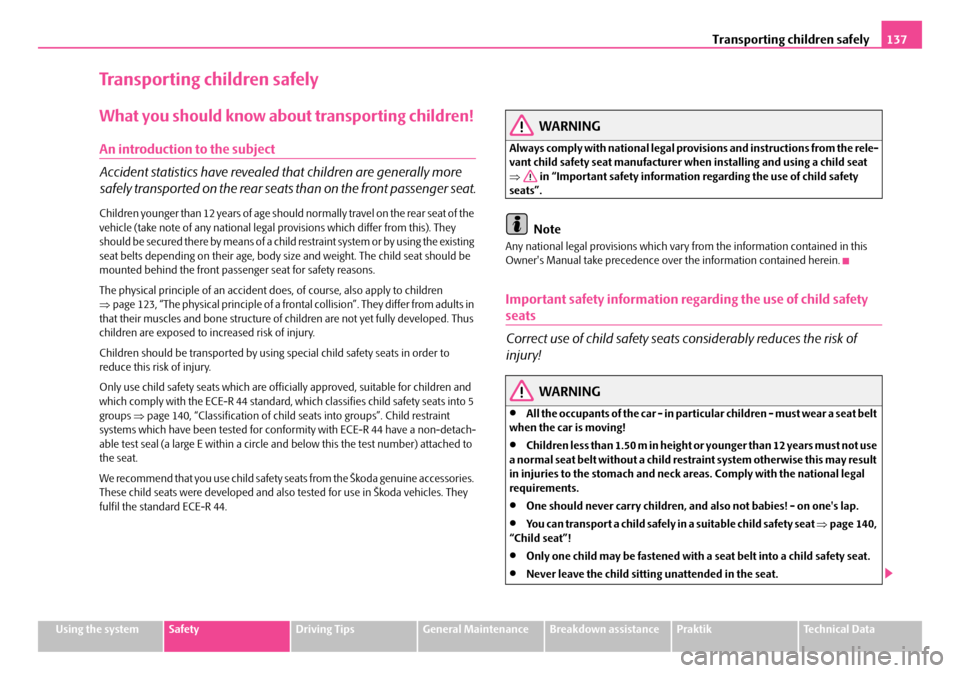
Transporting children safely137
Using the systemSafetyDriving TipsGeneral MaintenanceBreakdown assistancePraktikTechnical Data
Transporting children safely
What you should know about transporting children!
An introduction to the subject
Accident statistics have revealed that children are generally more
safely transported on the rear seat s than on the front passenger seat.
Children younger than 12 years of age should normally travel on the rear seat of the vehicle (take note of any na tional legal provisions which differ from this). They should be secured there by means of a child restraint system or by using the existing seat belts depending on their age, body si ze and weight. The child seat should be mounted behind the front passen ger seat for safety reasons.
The physical principle of an accident do es, of course, also apply to children ⇒ page 123, “The physical principle of a frontal collision”. They differ from adults in that their muscles and bone structure of ch ildren are not yet fully developed. Thus children are exposed to increased risk of injury.
Children should be transported by using special child safety seats in order to reduce this risk of injury.
Only use child safety seats which are offici ally approved, suitable for children and which comply with the ECE-R 44 standard, wh ich classifies child safety seats into 5 groups ⇒page 140, “Classification of child seats into groups”. Child restraint systems which have been tested for confor mity with ECE-R 44 have a non-detach- able test seal (a large E within a circle and below this the test number) attached to the seat.
We recommend that you use ch ild safety seats from the Škoda genuine accessories. These child seats were developed and also tested for use in Škoda vehicles. They fulfil the standard ECE-R 44.
WARNING
Always comply with national legal provisions and instructions from the rele-vant child safety seat manufacturer wh en installing and using a child seat ⇒ in “Important safety information regarding the use of child safety seats”.
Note
Any national legal provisions which vary from the information contained in this Owner's Manual take precedence over the information contained herein.
Important safety information regarding the use of child safety
seats
Correct use of child safety seats considerably reduces the risk of
injury!
WARNING
•All the occupants of the car - in particular children - must wear a seat belt when the car is moving!
•Chi ld re n le s s tha n 1. 5 0 m i n h e ig ht or younger than 12 years must not use a normal seat belt withou t a child restraint system otherwise this may result in injuries to the stomach and neck areas. Comply with the national legal requirements.
•One should never carry children, and also not babies! - on one's lap.
•You can transport a child safely in a suitable child safety seat ⇒page 140, “Child seat”!
•Only one child may be fastened with a seat belt into a child safety seat.
•Never leave the child sitting unattended in the seat.
NKO A05R 20 MR08.book Page 137 Wednesday, March 28, 2007 9:42 AM
Page 140 of 248
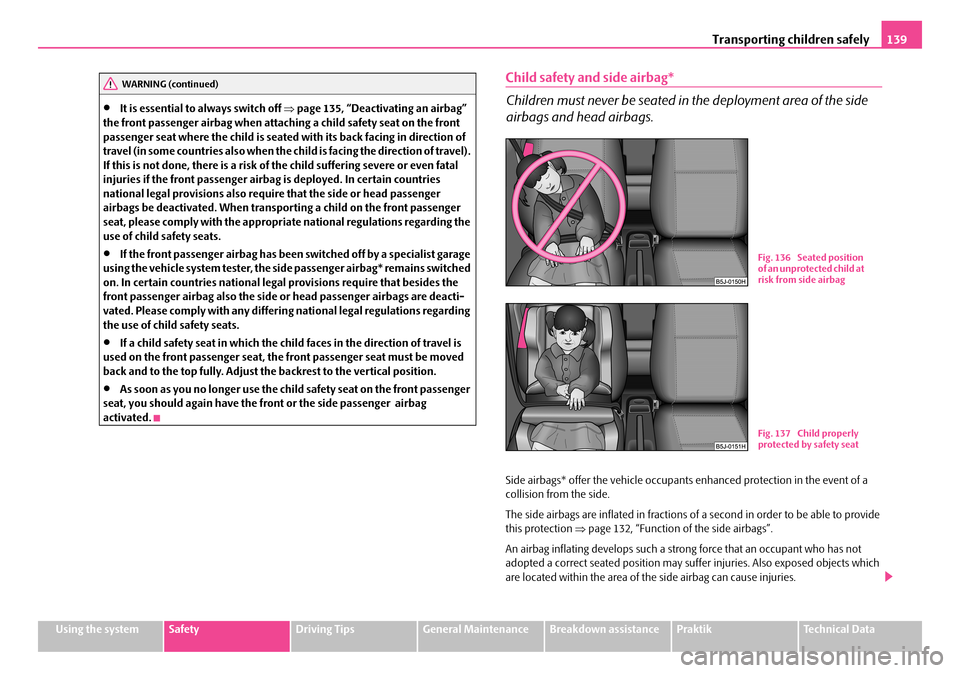
Transporting children safely139
Using the systemSafetyDriving TipsGeneral MaintenanceBreakdown assistancePraktikTechnical Data
•It is essential to always switch off ⇒page 135, “Deactivating an airbag” the front passenger airbag when attach ing a child safety seat on the front passenger seat where the child is seated with its back facing in direction of travel (in some countries also when the ch ild is facing the direction of travel). If this is not done, there is a risk of the child suffering severe or even fatal injuries if the front passenger airbag is deployed. In certain countries national legal provisions also requir e that the side or head passenger airbags be deactivated. When transporting a child on the front passenger seat, please comply with the appropri ate national regulations regarding the use of child safety seats.
•If the front passenger airbag has been switched off by a specialist garage using the vehicle system tester, the si de passenger airbag* remains switched on. In certain countries national legal provisions require that besides the front passenger airbag also the side or head passenger airbags are deacti- vated. Please comply with any differin g national legal regulations regarding the use of child safety seats.
•If a child safety seat in which the child faces in the direction of travel is used on the front passenger seat, the front passenger seat must be moved back and to the top fully. Adjust the backrest to the vertical position.
•As soon as you no longer use the chil d safety seat on the front passenger seat, you should again have the front or the side passenger airbag activated.
Child safety and side airbag*
Children must never be seated in the deployment area of the side
airbags and head airbags.
Side airbags* offer the vehicle occupants enhanced protection in the event of a collision from the side.
The side airbags are inflated in fractions of a second in order to be able to provide this protection ⇒page 132, “Function of the side airbags”.
An airbag inflating develops such a strong force that an occupant who has not adopted a correct seated position may suff er injuries. Also exposed objects which are located within the area of th e side airbag can cause injuries.
WARNING (continued)
Fig. 136 Seated position of an unprotected child at risk from side airbag
Fig. 137 Child properly protected by safety seat
NKO A05R 20 MR08.book Page 139 Wednesday, March 28, 2007 9:42 AM
Page 142 of 248
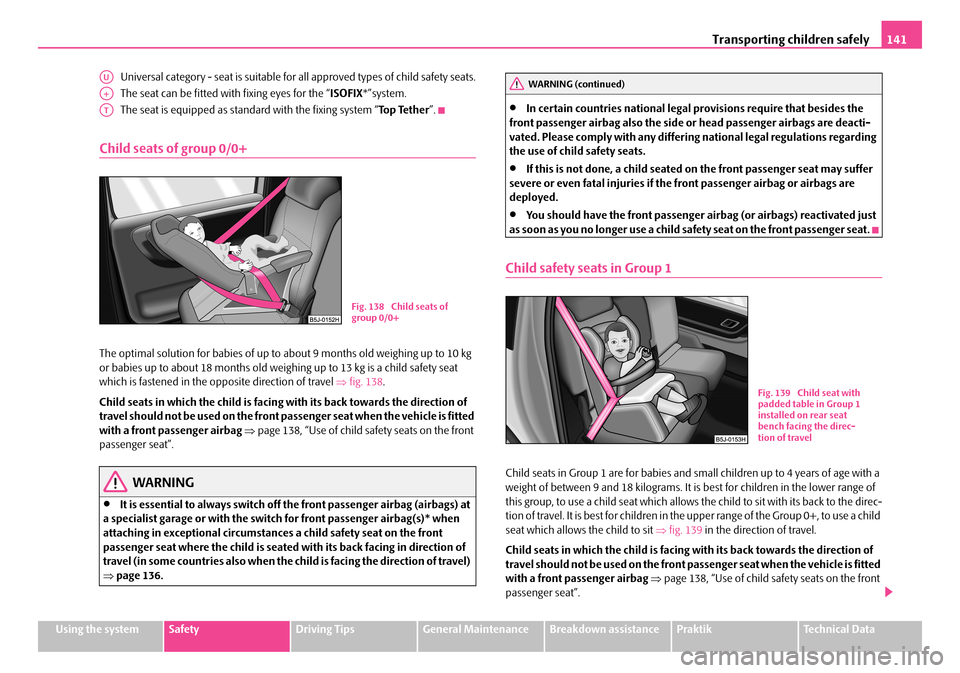
Transporting children safely141
Using the systemSafetyDriving TipsGeneral MaintenanceBreakdown assistancePraktikTechnical Data
Universal category - seat is suitable for all approved types of child safety seats.
The seat can be fitted wi th fixing eyes for the “ISOFIX*”system.
The seat is equipped as standa rd with the fixing system “To p Te t h e r”.
Child seats of group 0/0+
The optimal solution for babies of up to about 9 months old weighing up to 10 kg or babies up to about 18 mont hs old weighing up to 13 kg is a child safety seat which is fastened in the opposite direction of travel ⇒fig. 138.
Child seats in which the child is facing with its back towards the direction of travel should not be used on the front pa ssenger seat when the vehicle is fitted with a front passenger airbag ⇒page 138, “Use of child safety seats on the front passenger seat”.
WARNING
•It is essential to always switch off the front passenger airbag (airbags) at a specialist garage or with the switch for front passenger airbag(s)* when attaching in exceptional circumstances a child safety seat on the front passenger seat where the child is seated with its back facing in direction of travel (in some countries also when the child is facing the direction of travel) ⇒ page 136.
•In certain countries national legal provisions require that besides the front passenger airbag also the side or head passenger airbags are deacti- vated. Please comply with any differin g national legal regulations regarding the use of child safety seats.
•If this is not done, a child seated on the front passenger seat may suffer severe or even fatal injuries if the front passenger airbag or airbags are deployed.
•You should have the front passenger ai rbag (or airbags) reactivated just as soon as you no longer use a child sa fety seat on the front passenger seat.
Child safety seats in Group 1
Child seats in Group 1 are for babies and small children up to 4 years of age with a weight of between 9 and 18 kilograms. It is best for children in the lower range of this group, to use a child seat which allows the child to sit with its back to the direc- tion of travel. It is best for children in the upper range of the Group 0+, to use a child seat which allows the child to sit ⇒fig. 139 in the direction of travel.
Child seats in which the child is facing with its back towards the direction of travel should not be used on the front pa ssenger seat when the vehicle is fitted with a front passenger airbag ⇒page 138, “Use of child safety seats on the front passenger seat”.
AU
A+
AT
Fig. 138 Child seats of group 0/0+
WARNING (continued)
Fig. 139 Child seat with padded table in Group 1 installed on rear seat bench facing the direc-tion of travel
NKO A05R 20 MR08.book Page 141 Wednesday, March 28, 2007 9:42 AM
Page 144 of 248
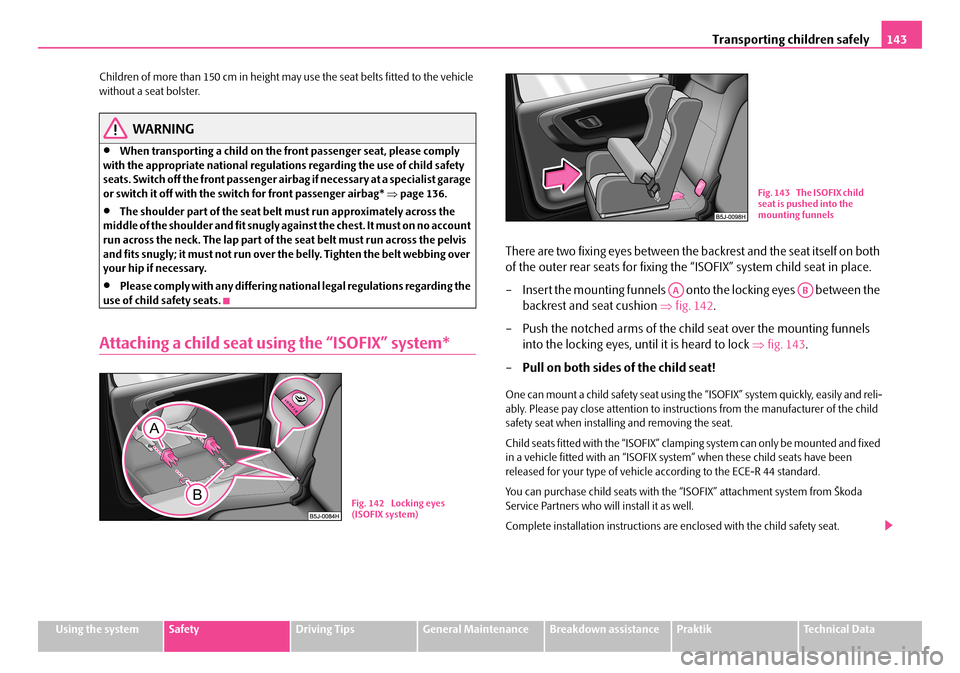
Transporting children safely143
Using the systemSafetyDriving TipsGeneral MaintenanceBreakdown assistancePraktikTechnical Data
Children of more than 150 cm in height may use the seat belts fitted to the vehicle without a seat bolster.
WARNING
•When transporting a child on the front passenger seat, please comply with the appropriate national regulations regarding the use of child safety seats. Switch off the front passenger airbag if necessary at a specialist garage or switch it off with the switch for front passenger airbag* ⇒page 136.
•The shoulder part of the seat belt must run approximately across the middle of the shoulder and fit snugly against the chest. It must on no account run across the neck. The lap part of the seat belt must run across the pelvis and fits snugly; it must not run over th e belly. Tighten the belt webbing over your hip if necessary.
•Please comply with any differing nati onal legal regulations regarding the use of child safety seats.
Attaching a child seat us ing the “ISOFIX” system*
There are two fixing eyes between the backrest and the seat itself on both
of the outer rear seats for fixing the “ISOFIX” system child seat in place.
– Insert the mounting funnels onto the locking eyes between the
backrest and seat cushion ⇒fig. 142.
– Push the notched arms of the chil d seat over the mounting funnels
into the locking eyes, until it is heard to lock ⇒fig. 143.
– Pull on both sides of the child seat!
One can mount a child safety seat using the “ISOFIX” system quickly, easily and reli- ably. Please pay close attention to instru ctions from the manufacturer of the child safety seat when installing and removing the seat.
Child seats fitted with the “ISOFIX” clampi ng system can only be mounted and fixed in a vehicle fitted with an “ISOFIX system” when these child seats have been released for your type of vehicle according to the ECE-R 44 standard.
You can purchase child seat s with the “ISOFIX” attachment system from Škoda Service Partners who will install it as well.
Complete installation instructions are enclosed with the child safety seat.
Fig. 142 Locking eyes (ISOFIX system)
Fig. 143 The ISOFIX child seat is pushed into the mounting funnels
AAAB
NKO A05R 20 MR08.book Page 143 Wednesday, March 28, 2007 9:42 AM